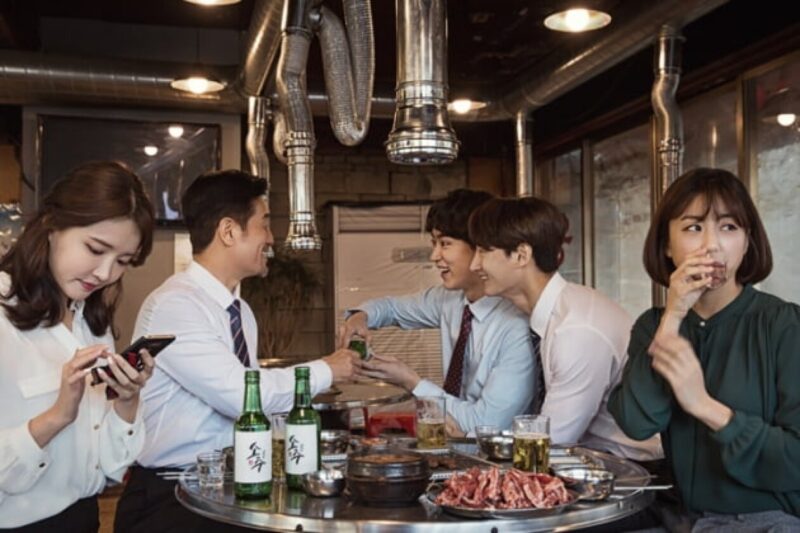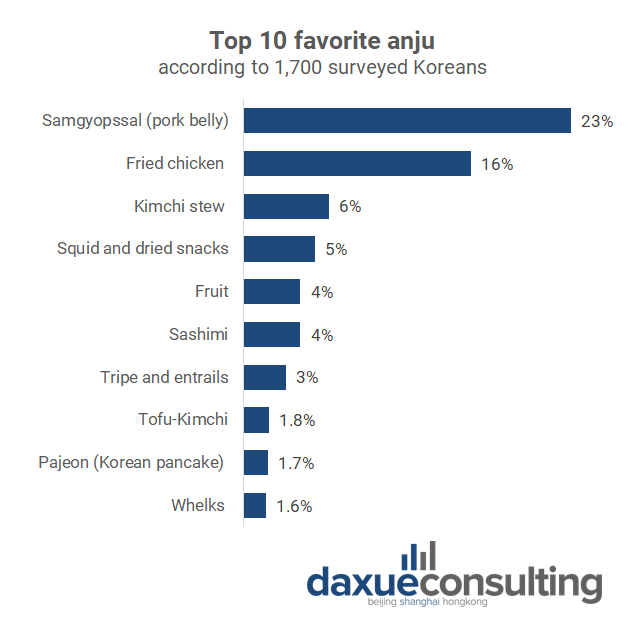The South Korean drinking culture is shifting from a social activity to an at-home indulgence. In the past, many people gathered frequently – either to have dinner with friends, pay respect to ancestors during ancestral rituals, and build relationships with coworkers. However, during the Covid-19 pandemic, people have developed a new consumption pattern: they are drinking alone at home.
Read our Korea F&B industry report

South Korea is a leading liquor consuming nation
In South Korea, drinking is a very important part of the culture. People drank in both casual and formal settings with their friends, family members, and coworkers. They drank so frequently to point that in 2014, South Korea was the leading hard liquor consumption country in the world. South Koreans drank 13.7 shots of liquor per week, followed by Russians who were at 6.3 shots per week and Americans at 3.3. However, the Covid-19 pandemic restricted people from meeting up with others and consumption dropped in the first two years. In 2022, however, the market started to gradually recover. South Korea’s alcoholic beverages market is worth USD $21.29 billion, and it is expected to increase by 6.56% CAGR until 2025.
Drinking etiquette is crucial in South Korea’s group drinking culture
Koreans often meet up with friends, family members, and coworkers and drink together. Especially before the pandemic, hweshiks, or company dining and drinking events among coworkers, were common.
As drinking is a large part of work and social culture, Koreans learn strict drinking etiquette. Whether a native or a foreigner, understanding drinking etiquette is essential to understand. As a country that has been largely influenced by Confucian values, hierarchy is important, meaning the young should respect the old and the more junior should respect the senior. When drinking, subordinates should hold onto their glass with both hands whether they are the ones to pour the alcohol or to receive it from the older person. It would be disrespectful to use only one hand. Also, when drinking, subordinates should turn their heads to the side while covering their mouth. These drinking formalities are more relaxed, however, when drinking with friends.
South Korean office workers are feeling less pressured to drink with others
Many people in South Korea are no longer feeling the pressure to attend their company’s hweshiks (회식). In the pre-pandemic period, many people were immensely peer pressured to attend these company gatherings, which are typically held outside of working hours. They typically take all evening, with second and third rounds of events like going to another drinking venue or going to noraebang (노래방), Korean-style karaoke rooms.
Although hweshiks are meant for company workers to open up and strengthen their relationships, they don’t always serve that purpose. The younger generation is questioning the peer-pressure-oriented hweshik activities, as some feel they reinforce an authoritarian culture.
However, the Covid-19 pandemic and its social distancing measures have given people a valid reason (and less pressure) to excuse themselves these endless evenings of drinking. 60.6% of survey respondents said there seems to be a reason to avoid the hweshiks, according to a survey conducted by Embrain Trend Monitor (엠브레인 트렌드모니터). In the same survey, 50.8% of the respondents were satisfied that the number of these gatherings has decreased.

“Homsul” and “honsul”, at-home drinking, rise as post-work drinking culture declines
With the Covid-19 social restrictions, there are two major drinking trends on the rise: homsul (홈술), or drinking at home, and honsul (혼술), or drinking alone. According to a 2020 report, the “preferred trend” was home drinking (67.9%) and enjoying alcohol (50.0%). Single-person households have increased during the pandemic, providing opportunities for individuals to stay at home and alone.
With the rise of these trends, the wine market is experiencing unprecedented growth. People are buying wine as it can be drunk more slowly compared to soju (소주), or South Korean distilled alcoholic beverage, and beer, two of the leading alcoholic beverages in Korea. To satisfy these needs, many convenience stores like Emart24 (이마트24), GS25, and CU, are offering them. CU, for example, launched Wine Half Bottle Casho (와인 반병 까쇼) targeting the homsul consumers specifically.
“Anjus” or drinking snacks, accompany South Korean drinking culture
In South Korea, people are most likely to order anju (안주), a snack/side dish that usually accompanies drinking. Anjus include a wide range of dishes from grilled meat and fried chicken to dried snacks and fruits. They can be served as a set of smaller dishes or one large dish. Some of the most popular in South Korea F&B market are samgyopssal (삼겹살, pork belly), fried chicken (치킨), and kimchi stew (김치찌개).

Before the pandemic, many people often got their anjus in pojangmacha (포장마차), or small tents/stalls founds in the streets, noraebangs, and bars. But now they can get them in other more convenient places like convenience stores. For example, CU, a leading South Korean convenience store chain, offers a wide variety of snacks like its most popular refrigerated snack series the Giant (자이언트). They also have PICK (편픽), a pickup service that allows consumers to pick up the products they deliver in advance.

Chimaek (치맥) is one of the most popular pairings in South Korean drinking culture
South Koreans typically pair an anju with an alcoholic beverage. Among the most popular anju-alcohol pairings is Chimaek (치맥), which refers to Korean chicken and beer combination. It has become so popular it has been portrayed in K-dramas like My Love from the Star (별에서 온 그대). CASS (카스), Terra (테라), and Hite (하이트) are some of the top beers, while Kyochon Chicken (교촌치킨), BHC, Goobne Chicken (굽네치킨) are some of the leading chicken chains.
Low alcohol content beverages are on the rise
As group drinking is decreasing, people want to enjoy light alcohol consumption alone at home. In a survey conducted by Lotte Members, more than twice of the respondents said they preferred low (70.8 percent) over high alcohol content beverages (29.2 percent). In response, brands have launched lower their alcohol content level. For example, Starlight Chungha (별빛 청하) was launched by Lotte Chilsung Beverage (롯데칠성음료) with an alcohol content of 7 percent, half the level of the regular Chungha of 13 percent.
In addition to low alcoholic content, people are preferring small-volume over large-volume alcoholic beverages. In the same survey, 77.0 percent of respondents preferred “small-volume alcohol”. E-dong 1957 (이동주조1957) released a “one bottle per person” makgeolli (막걸리), or South Korean rice wine. It reduced the size to 500 ml from its existing 750 ml version.
Key takeaways on South Korean drinking culture:
- Drinking plays a significant role in Korean culture, especially in work culture. However, the young generation is challenging the peer-pressure-based tradition.
- Korean drinking etiquette is based in hierarchy. For example, the younger person should use both hands to pour and receive alcohol.
- The Covid-19 pandemic has shifted Korea’s drinking culture from outside to at-home, and from groups to alone.
- Koreans eat anjus (안주, drinking snacks) with alcohol. One of the most popular pairings is Chimaek (치맥, Korean chicken + beer). Unlike the past, they can get them more easily like in convenience stores such as CU.
- Low alcohol content and small-volume beverages are coming into favor. In response, brands like Lotte Chilsung Beverage have adjusted the alcohol content of one of their existing products. Similarly, E-dong 1957 has reduced the size of one of its existing products from 750 ml to 500 ml.





